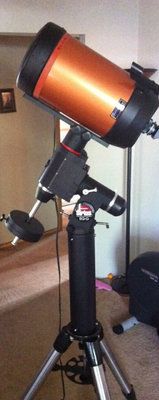I swapped out the tripod (1.75"OD legs) with the sturdier tripod (2.0"OD legs) from the CG-5 asgt mount. I ordered and installed the Orion 16" SVP Pier extension, which is compatible with both tripods. After learning how to polar align the cg-5, I decided I wasn't going to crawl on the ground anymore. I must admit, with the scope and mount attached to the pier extension, it is quite a formidable setup.
Another shot of the "Twins":
I put the trade scope on the CG-5 ASGT mount and plan to use for visual use or planetary imaging while I do my DSO subs with the NS8SE OTA on the Sirius mount.
About the Sirius mount. There sure isn't as much review information on the internet as it's big brother, the atlas. The motors and controls are the same, however the payload limit of this system is rated at 30lbs. I figure my OTA with eventual guidescope package and imager will place it between 16-18 lbs depending on the imager used. A little over half of the visual rating, it means I will have to give extra attention to balancing if I plan to be successful with AP. I am also thinking real seriously about going the hyperstar route next year at tax time.
The motors on the Sirius mount are amazingly quiet when compared to my CG-5. The CG-5 is pretty loud, and although it never really bothered me before, compared to the Sirius I can see where they can get annoying. The mount was purchased originally without a hand controller, so I connect to the mount using EQMOD/EQASCOM and sync goto's with Cartes du Ciel. I really didn't like CdC at first, being familiar with stellarium and all, but I have to admit that it has grown on me. Uncle Rod pointed me in the right direction to get it setup in a similar fashion to stellarium.
About EQMOD. This program is simply amazing, giving me much more control and trouble-free operation than NexRemote ever could. It is a bit of informational overload, due to the never-ending list of features. The trick is to take several nights and take small bites, rather than try to chew on it all at once. I took several nights learning different features and over the course of last week, I feel pretty confident in using it. I downloaded the voicepack and installed it so now the mount talks to me when operating. Audible alerts and announcements are completely customizable, allowing any sound or .wav to be assigned to nearly every aspect of mount/scope operation. I am currently compiling some star trek computer sounds to plug in, because yes, I am that big of a nerd. I will say this about EQMOD, it is light-years ahead of NexRemote.
So my plans are, for the moment...to sell the Nexstar 8 altaz mount (350 with manual, nexremote software, HC extender, HC, computer/hand control cable, no power cord) and purchase an Orion SSAG package. I also plan on selling my DMK21 monochrome imager (300) and purchasing the color equivalent DFK/DBK21 for planetary imaging (since only needed monochrome for h-alpha imaging).
Tonight will be first light with this new setup. Hoping for clear skies and good luck!



No comments:
Post a Comment